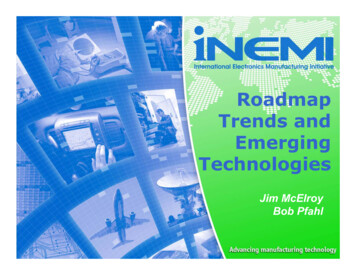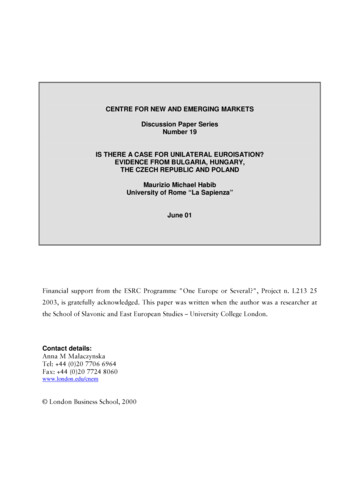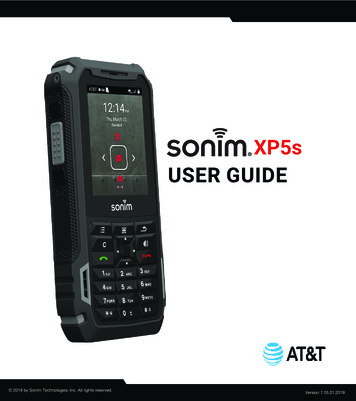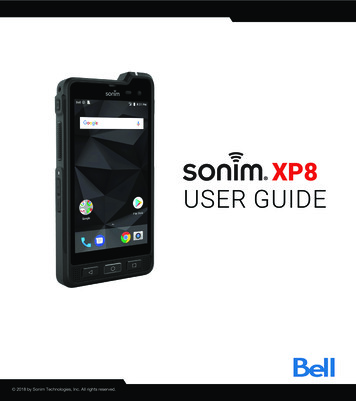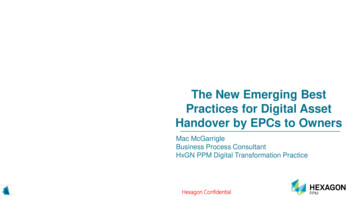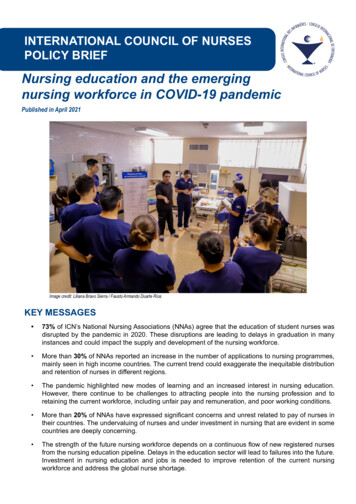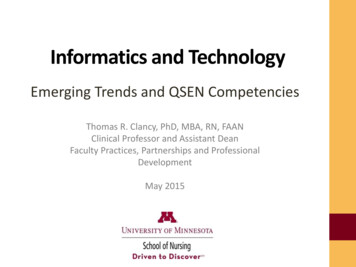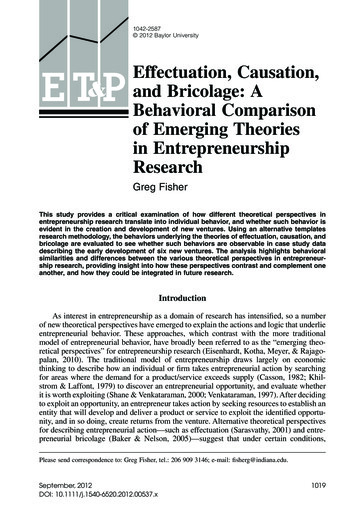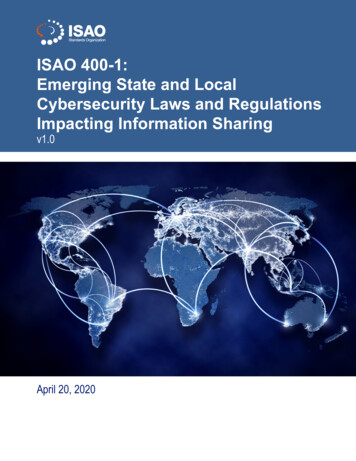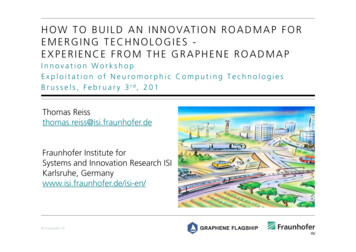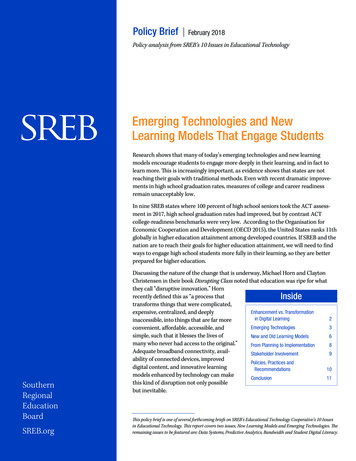
Transcription
Polic BriefFebruary 2018Policy analysis from SREB’s 10 Issues in Educational TechnologyEmerging Technologies and NewLearning Models That Engage StudentsResearch shows that many of today’s emerging technologies and new learningmodels encourage students to engage more deeply in their learning, and in fact tolearn more. Tis is increasingly important, as evidence shows that states are notreaching their goals with traditional methods. Even with recent dramatic improvements in high school graduation rates, measures of college and career readinessremain unacceptably low.In nine SREB states where 100 percent of high school seniors took the ACT assessment in 2017, high school graduation rates had improved, but by contrast ACTcollege-readiness benchmarks were very low. According to the Organisation forEconomic Cooperation and Development (OECD 2015), the United States ranks 11thglobally in higher education attainment among developed countries. If SREB and thenation are to reach their goals for higher education attainment, we will need to fndways to engage high school students more fully in their learning, so they are betterprepared for higher scussing the nature of the change that is underway, Michael Horn and ClaytonChristensen in their book Disrupting Class noted that education was ripe for whatthey call “disruptive innovation.” Hornrecently defned this as “a process thatInsidetransforms things that were complicated,Enhancement vs. Transformationexpensive, centralized, and deeplyin Digital Learning2inaccessible, into things that are far moreEmerging Technologies3convenient, afordable, accessible, andsimple, such that it blesses the lives ofNe and Old Learning Models6many who never had access to the original.”From Planning to Implementation8Adequate broadband connectivity, availStakeholder Involvement9ability of connected devices, improvedPolicies, Practices anddigital content, and innovative learningRecommendations10models enhanced by technology can makeConclusion11this kind of disruption not only possiblebut inevitable.Tis policy brief is one of several forthcoming briefs on SREB’s Educational Technology Cooperative’s 10 Issuesin Educational Technology. Tis report covers two issues, New Learning Models and Emerging Technologies. Teremaining issues to be featured are: Data Systems, Predictive Analytics, Bandwidth and Student Digital Literacy.
tainly, the ingredients for change are in place. SREB states need ways to improve student outcomes;they have innovative ideas that are backed by evidence and research; most have sufcient technologyand supportive technology infrastructure.Enhancement vs. Transformation in Digital LearningOver time, new technology tools can transform student learning. Te process begins by substitutingtechnology tools for more traditional ones. Te new tools augment learning and fnally transform it,leading to redesigned and more personalized outcomes. Students experience deeper learning and feelgreater ownership of their educational paths, along with greater synthesis of knowledge in studentcreated projects and portfolios.Too often, traditional classrooms lag behind in mainstream adoption of technologies that can unlockthe full educational potential of a classroom — even as the students use the same devices for otherpurposes in leisure time. Tis is a missed chance. With the right nudge, new technology tools canchange students’ learning — from passively absorbing what a teacher delivers to discovering andapplying those lessons in new ways, evaluating and synthesizing multiple ideas.Researchers have recognized a pattern of teacher and student interaction with new technology tools.In 2006, Ruben R. Puentedura introduced the SAMR model of technology integration: substitution,aug-mentation, modifcation, then redefnition. As the tools are frst introduced for educational use,educators substitute a new technology practice for a current one. Ten teachers or students fgure outhow the tool will help them augment — extend or become more efcient — in relation to their practice.Eventually teachers and students discover how the tool can be modifed to help them do somethingentirely new. It is then that the tool takes on a transformation role in student learning. Tey begin tore-defne the tool for their own purposes — to use it in a diferent, perhaps more innovative, way thanfrst envisioned.Mobile phones are an example of both the SAMR model and a disruptive innovation. Early mobilephones, around 1980, were designed for automobiles, even though they were not connected to cars.Some came in carrying bags because they were large and heavy, and too unwieldy to carry. Tey substituted for land-line and pay phones, giving business people instant communication on the road.Business consumers soon called for phones to augment more general business mobile communication.Tough still bulky by today’s standard, the lighter next-generation mobile phones could be moved moreeasily, and they soon augmented communication for both business consumers and the general public.With the advent of smaller batteries, voicemail and texting capabilities, consumers and entrepreneurstransformed the phones into highly mobile devices allowing callers to communicate with people evenif they did not catch them at their devices. As cell phones gained processing capacity and were able toFIGURE 1: SAMR ModelRedefnitionModifcationAu mentationSubstitutionPolicyNoTechnolo y2
support auxiliary functions, consumers wanted calendars, clocks, cameras, fashlights and the internetat their fngertips, and these preferences led to mobile apps for every imaginable purpose. Today’s smartphone has transformed how we interact with the world, and has replaced pagers, palm pilots, watches,digital cameras, video cameras and global positioning systems (GPS).Online education also fts both the SAMR and the disruption model. In the early 1990s online educationwas generally approached as a substitute for classroom instruction. Teachers used the same kinds oflectures, presentations, handouts and assignments in their online classes as in their face-to-face classes.In the augmentation stage, online teachers began to realize that the online environment gave them someadvantages and presented some obstacles. In learning to maximize the advantages and overcome theobstacles, they made full use of the functional advantages the technologies ofered. Tese includedautomated grading applications for objective tests, tracking student participation electronically, andmanaging online test banks. Learning management systems (LMS), which became available in themid- to late- 90s, disseminated information to students, while they gathered resources and recordedgrades and attendance. Te LMS also began to capture data about students’ learning experiences.Te data from these resources brought about instructional redesign and led to signifcant coursemodifcation. Better digital content, interactive software applications, and better bandwidth also madeit possible for the instructors to create better projects or assignments. Data collected in the LMS andstudent information systems provided better insight about learning. Tese insights spurred the facultyto redesign their courses and teaching. Te redefnition stage — with the use of the technology —allowed faculty to create assignments they could not have created otherwise. Tis stage led to self-paced,self-directed learning, and adaptive content that adjusts to the learner’s prior knowledge or skills gaps,using competency-based learning outcomes. Teachers were able to include educational technologies,such as simulations, games, virtual reality, and artifcial intelligence engines to transform the way theyinstruct their students.Researchers indicate that substitution and augmentation are the enhancement stage for the use oftechnology tools. When the use of technology reaches the modifcation and redefnition states, theimpact is considered transformative. Online, virtual, or digital education is at the transformation stage,bringing about disruptive innovation in education.For states to beneft from the advantages these tools can bring, they need to support the eforts ofschools and teachers who are working to implement change and help them to foster state-wide scalingof their eforts.5EmergingTechnologiesFactor the relevance and appropriate use of emer intechnolo ies in strate ic decision makin and fosterfaculty professional development in these technolo iesto maximize their benefts to students.Emerging TechnologiesEducation administrators are most concerned about instructional efectiveness —not with promotingthe use of new tools for the sake of integrating technology into the classroom — and rightly so. Evenif new tools are available, practical issues often impede the efective use of them, including: trainingto ensure teachers, principals/administrators and support staf know how to use the technologies;sufcient infrastructure and bandwidth to support the new instructional methods; policies that provideaccess and authorization; and technology teams that support instructional use while protecting privacyEmerging Techologies and New Learning Models February 20183
EmergingTechnologiesNewLearningModelsand security of the students, employees, and institutional assets. Nevertheless, administrators, policies,and infrastructure should be fexible enough to experiment with emerging technologies so that studentscan make use of them to engage more deeply in their learning, to improve persistence and completionof degrees or diplomas and to prepare for the 21st century workforce.Even teachers and administrators who want to embrace new technologies fnd it difcult to keep upwith the ever-changing landscape. Technology changes so quickly that keeping up with emergingtech-nologies is nearly impossible, which is why some have substituted the term “bleeding edge” forwhat others have called the “leading edge.” To help educators make sense of the types and uses of newtechnologies targeted for higher education, Eduventures mapped more than 600 technologies in 2017,showing their features and capabilities. Teir intended use — business or industry or social — oftenpredetermines which ones reach the mainstream. Tools designed for instructional use often lagbehind those designed for business and industry. Cross-uses of tools from one sector to another isnot uncommon.Gartner, Inc. has developed a way of charting the cycle of technology trends that has proven helpful inputting emerging technologies into perspective. Te Gartner Hype Cycle provides a way for business andeducation practitioners to stay abreast of technology trends and to project the path a new technologytool might take once it has been launched. Some, according to the cycle, will be short-lived, and somewill be transformational. Gartner’s Hype Cycle traces technology trends through fve stages on one axisof time and another of expectations: the innovation trigger, the peak of infated expectations, thetrough of disillusionment, the slope of enlightenment, and the plateau of productivity. It helps sortout technology tools or systems and provides a timeline for likely adoption into the mainstream.FIGURE 2: Gartner Hype CyclePeak of ccessibilityeofnnmehtegilEntPlateau ofProductivityTrough ofDisillusionmentTimeSource: Gartner, Inc. Tis graphic was published by Gartner, Inc. as part of a larger research document and shouldbe evaluated in the context of the entire document. Te Gartner document is available upon request hodologies/hype-cycle.jsp.Policy4Note:Gartner does not endorse any vendor, product or service depicted in its research publications, and doesnot advise technology users to select only those vendors with the highest ratings or other designation.Gartner research publications consist of the opinions of Gartner's research organization and should not beconstrued as statements of fact. Gartner disclaims all warranties, expressed or implied, with respect to thisresearch, including any warranties of merchantability or ftness for a particular purpose.
Gartner’s 2017 educational technology hype cycle places the emerging education technologies on thissame timeline, allowing educational agencies the beneft of strategically planning for integration ofthe most productive and efective tools. It indicates the time it takes for education technology tools toreach mainstream adoption, up to 10 years. Some tools may be fads and fzzle immediately or becomeobsolete before they reach mainstream adoption. Education agencies that use the hype cycle, however,have a better chance of not implementing outmoded tools.Schools teams should consider all aspects of how they will implement any new educational technology. Otherwise, they may fnd that what appeared to be a simple addition to their routines is reallya daunting task that requires expertise beyond that of a typical teacher or principal. Some of theseconsiderations include:ncomparing total cost of ownership, including infrastructure as well as equipmentnmeasuring classroom efectiveness of the toolnvetting similar tools to determine the best onenintegrating the tools into teaching processesnassuring privacy and security of devicesnproviding for access to and protection of data generated by new toolsnplanning for scalability and comprehensive implementation for widespread adoptionnassuring compatibility and interoperability of devices with existing systemsnplanning an exit strategy in case the vendor leaves the market or improved technologybecomes available, for example determining how to retrieve data or other intellectualproperty in a usable format or disentangling the tool from systems or processesnsupporting various apps, operating systems, and devicesnassuring vendor agrees to provide technical support to resolve problems if user determinesthat vendor’s software or browser upgrades interfere with technologies customer previouslyadopted or cause unexpected errors that students or faculty cannot resolvenensuring accessibility for students with disabilitiesnaligning technology use with student outcomes, andntraining for teachers, administrators, and support staf for efective use and evaluation.Most emerging educational technology tools begin with a teaching purpose. But many of them fndtheir way to the classroom from social, business or game applications. Consider social tools likeFacebook, Twitter and Instagram which are now used in classroom instruction, but only aftermainstream adoption by the general population.Virtual worlds in 3D, such as Second Life, had a slow start in education because faculty and studentsfound them difcult to learn, and research provided little evidence that they were efective in promoting learning outcomes. But tools such as Second Life, Minecraft, OpenSim, World of Warcraft, and Unityhave now found their way into classrooms, because they help students build and create things withinspecial learning applications. For example, health care workers in training can build virtual hospitals,and military personnel in training can build virtual battlefelds, both groups preparing for missionswith simulated experiences and scenarios they might encounter on the job. Recent publications by theInternational Society for Technology in Education (ISTE) and Government Technology indicate thatvirtual reality and gaming have the kind of positive “disruptive” efect on military training that HornEmerging Techologies and New Learning Models February 20185
DataSystemsdescribed. Te U.S. military uses such applications as training tools for soldiers to simulate dangeroussituations without actually putting the soldiers in harm’s way.DataPrivacyHeating, ventilation, air conditioning, and refrigeration (HVAC-R) businesses are using virtual realityheadsets to train new employees. Tey employ senior technicians who can no longer endure thephysical labor of the jobs, but who have extensive experience in HVAC-R. From a computer in anofce, the senior technicians help the rookies troubleshoot jobs without having to climb ladders ontoindustrial rooftops or move large equipment. Instructors and administrators in traditional educationalsettings need to be aware that businesses are using these types of technology, so they can preparetheir students for the work environments they will soon enter.PredictiveAnalyticsIntegrating the emerging technologies into classroom instruction and curriculum is important. Manyof the failed technology integrations have resulted from poorly planned implementation, failure tointegrate technology tools into classroom teaching practices, or inadequate training in how to use thetools properly.Bandwidth6EmergingTechnologiesNew LearningModelsProvide for more use of technolo y to create personalized, competency-based learnin environments anddelivery methods which allow students to demonstratemastery of content at their own pace.New and Old Learning ologySecurityDigitalAccessibilityPolicy6Few “new” learning models are entirely new, but new digital learning tools have revitalized many. Having students’ diagnostic information readily available throughout the learning process can help teachersturn passive learning models into adaptive ones that are much more attuned to the individual student.Teachers can also use data mining, predictive analytics, or artifcial intelligence to learn more quicklyabout their students’ individual learning styles and gain insights into how to direct their learning paths.Te data that learning management systems can gather and analyze about students throughout anonline course can help faculty improve course design and teaching practices. Data dashboards provideteachers greater insight into student progress and specifc struggles, so teachers can provide timelyintervention. All of these advances require digital tools.As teachers have brought several learning modelstogether and added technology tools to support themodels, they have been catalysts for educationtransformations. An example of this is personalizedlearning, which incorporates both competencybased and adaptive learning. Together they dependon sophisticated systems of diagnostic and formativeassessment and adequate data systems to deliverassessment data to teachers systematically, so theycan guide students toward individual paths forlearning. Technology tools have changed competencybased education and adaptive learning — and havegone a long way toward creating a new way ofconceptualizing personalized learning.Ke Defnitions:Competency-based learningStudents move throu h a course at their own pace asthey master pre-determined competencies set for thecourses. Course len th is not defned by a calendar andcredits are measured by competencies mastered, not byCarne ie units.Adaptive learningLearnin is sequenced by technolo y tools that reco nizewhen students have or have not met competencies andpresents learnin materials accordin ly, stressin unlearned concepts as needed or movin ahead as permitted. It incorporates mastery learnin because the studentdoes not move forward until she/he has mastered theconcepts, leavin no aps in knowled e.
Just as competency-based education and adaptive learning can stand alone, so can other instructionalelements that are sometimes incorporated into personalized learning. Project-based and servicelearning, which help students to apply knowledge to life situations, have been improved throughuse of technology tools, such as virtual reality, simulations and gaming. Te fipped classroom —a blending of online and face-to-face
Gartner research publications consist of the opinions of Gartner's research organization and should not be construed as statements of fact. Gartner disclaims all warranties, expressed or implied, with respect to this research, including any warranti
